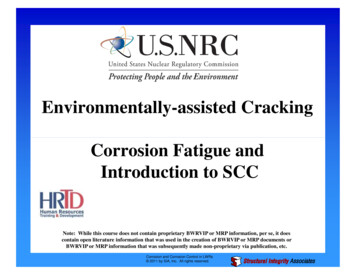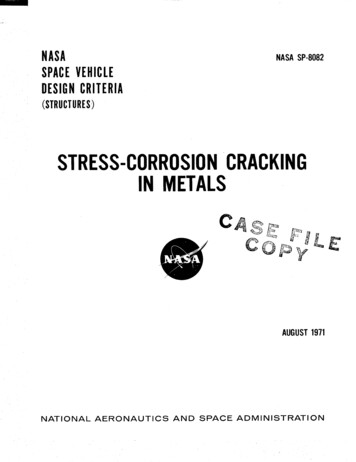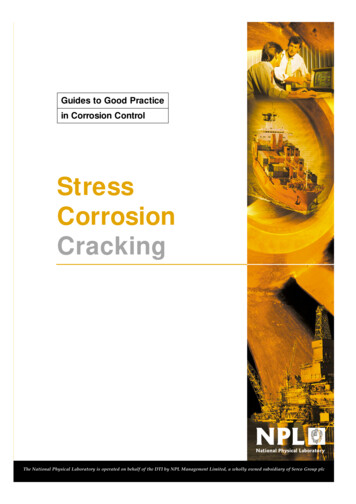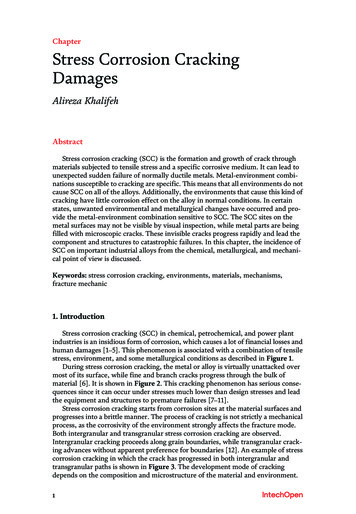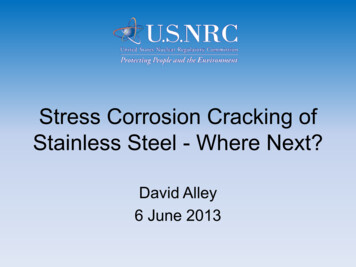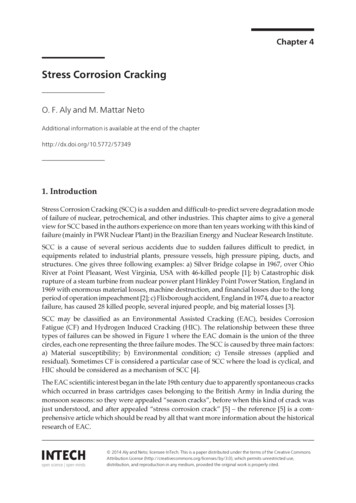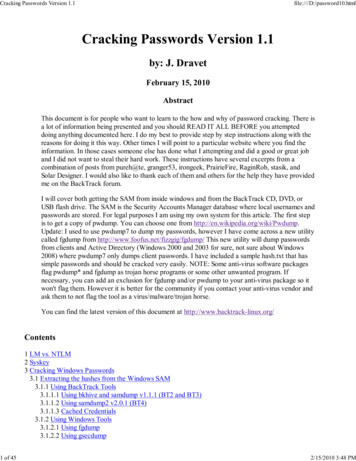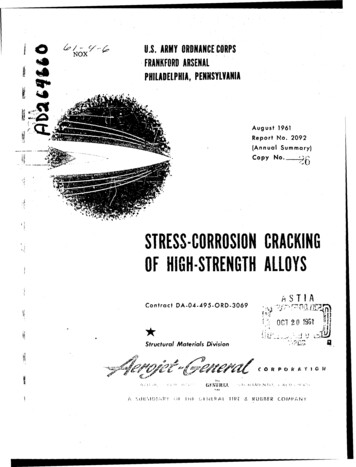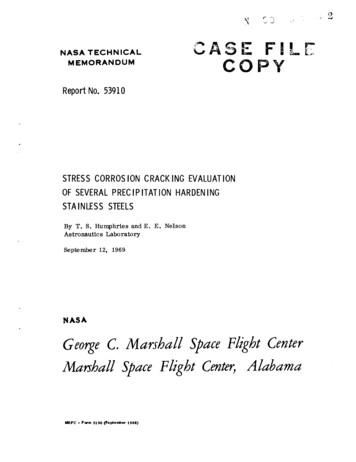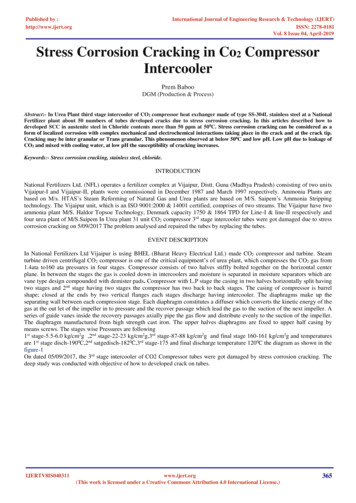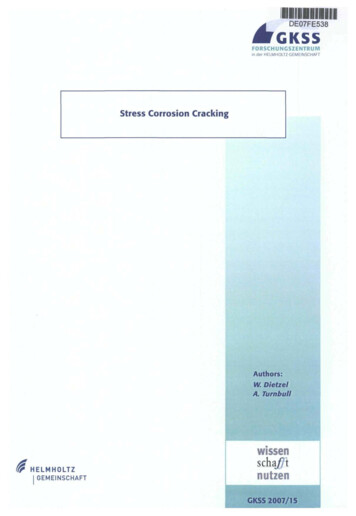
Transcription
DE07FE538GKSSFORSCHUNGSZENTRUMin der HELMHOLTZ-GEMEINSCHAFTStress Corrosion CrackingAuthors:W. DietzelA. SS 2007/15
Stress Corrosion CrackingW. DietzelGKSS, Geesthacht, GermanyA. TurnbullNational Physical Laboratory, Teddington, UKThis article was originally written in the form of a chapter in:Comprehensive Structural Integrity, Online UpdateFracture of Materials from Nano to MacroISBN: 0-08-043749-4 (Set)New Online Volume 11ISBN 978-0-0804-3749-4pg. 43-74.Original Print Edition Editors: Milne, R.O. Ritchie, B. Karihaloo (Editors)Online update available at: www.sciencedirect.com Copyright 2007, Elsevier Ltd., All Rights Reserved.Comprehensive Structural Integrity is a reference work which covers all activities involved in the assurance ofstructural integrity. It provides engineers and scientists with an unparalleled depth of knowledge in thedisciplines involved. The scope covers all industries and technologies, from the massive offshore structures tothe miniscule biological structures, and includes consideration of heavy section structures, thin sheet structures,and structures at the nano scale. Volume 1 covers these issues in general, using examples and case studies to givepractical examples of how the disciplines are applied. Volumes 2 to 6 address the underlying theories andmethodologies, covering theoretical and computational methods, fatigue, environmental influences, and hightemperature effects. Volume 7 covers practical failure assessment methods, and addresses the assessment ofstructures which contain crack-like defects. Volumes 8 and 9 cover in turn, interfacial and nano-scale failure andthe treatment of structures engineered for bio-medical applications. A subject index is contained in Volume 10 ofthe print edition and the new online Volume 11 is dedicated to the mechanical characteristics of materials.Comprehensive Structural Integrity provides a first point of entry to the literature for both the engineer andresearcher across the whole field of structural integrity.Comprehensive Structural Integrity is published by Elsevier, and this article is reprinted with the permission ofElsevier.Information about Comprehensive Structural Integrity can be obtained fromwww.elsevier.com or www.sciencedirect.com
11.03Stress Corrosion CrackingW. DIETZELGKSS-Forschungszentrum Geesthacht GmbH, Geesthacht, GermanyA. TURNBULLNational Physical Laboratory, Teddington, UK11.03.1INTRODUCTION4411.03.2 GENERAL ASPECTS OF SCC TESTING11.03.2.1 SCC Test Philosophies11.03.2.2 Specimen Configuration and Loading Mode11.03.2.3 Environment Control11.03.2 4 Time-Dependent Issues464647484911.03.3 NON-PRECRACKED SPECIMENS11.03.3.1 Constant Load Tests11.03.3.2 Constant-Displacement Tests11.03.3.3 Slow Strain Rate Tests11.03.3.4 Breaking Load and Linearly Increasing Stress Tests505051525411.03.4 PRECRACKED SPECIMENS - THE FRACTURE MECHANICS APPROACH TO SCC11.03.4.1 Linear Elastic Fracture Mechanics11.03.4.2 Requirements of Fracture Mechanics SCC Testing11.03.4.3 Loading Mode11.03.4.4 Constant-Load Tests11.03.4.5 Constant-Displacement Tests11.03.4.6 Rising-Load and Rising-Displacement Tests5455565757585911.03.5 CRACK GROWTH MEASUREMENT11.03.5.1 Electrical Resistance Measurement Methods11.03.5.1.1 DC potential drop method11.03.5.1.2 AC potential drop method11.03.5.2 Compliance Methods616161636311.03.6 LIMITATIONS OF THE LEFM APPROACH TO SCC11.03.6.1 The ./-Integral11.03.6.2 Crack-Tip Opening Angle/Displacement11.03.6.3 Shallow Cracks6364656611.03.7 THE USE OF SCC DATA11.03.7.1 Predicting the SCC Behavior of Materials and Structures11.03.7.2 Studies of SCC Mechanisms67676711.03.8 GUIDE TO SELECTION OF MECHANICAL SCC TEST METHOD6911.03.9 CONCLUDING REMARKS7211.03.1073REFERENCES43
Stress Corrosion Cracking44NOMENCLATURE 5 5 caAatfv LLVZcrack size, half length of a centercrack, crack depth for a surface crackelongation to fractureinitial crack sizespecimen thicknesshalf crack length for a surface crackapplied deformation rate measuredat the tip of the fatigue precrack(effective) diffusivity of hydrogenatomsmodulus of elasticitymodulus of elasticity for constraintconditionsfracture energyapplied forceyield load/-integralvalue of / at 0.2 m m of stable crackextensionvalue of / at initiation of environmental crack extensionlinear elastic stress intensity factorlinear elastic stress intensity factor,crack opening mode 1plane-strain fracture toughnessthreshold value of the stress intensity factor for the onset ofenvironmental crackingfracture resistance in terms of Kratio of K\ and Kmalratio of applied load to yield load,F/Fyload point displacement (general)elastic limit of a steel with a Lüdersplateaudistance behind the crack tip formeasuring 6Ctensile strengthyield strength equivalent to 0.2 percent proof stresstime to failureload-line displacementcrack-mouth opening displacementreduction in area 55crack-tip opening displacementAa0Bcdös/dtEEE,FFYJJQ.2 SCCKK\K\c ISCCKm.MKTLxqRe\rmRm PO.2 plSlotVaOmilay*l Acritical crack-tip openingdisplacementaverage crack extensionstrainelastic strainplastic straintotal strainPoisson's ratiostressinitial stressyield strengthcrack-tip opening anglecritical value of ip at initiation ofcrack extensionABBREVIATIONSSpecimen TypesC(B)C(T)DCBSE(B)WOLcantilever bendcompactdouble-cantilever beamsingle-edge notchwedge open ASCCSEMSSRTTGSCCconstant-extension rate tensile( slow strain rate)crack-mouth openingdisplacementcrack opening displacementcrack-tip opening anglecrack-tip opening displacementenvironmentally assistedcrackingintergranular stress corrosioncrackinglinearly increasing stress testlinear variable displacementtransducerreduction in areastress corrosion crackingscanning electron microscopeslow strain rate testtransgranular stress corrosioncracking(CTOD)11.03.1INTRODUCTIONStress corrosion cracking (SCC) describes theinitiation and growth of cracks caused by thesynergistic combination of a nominally static,or slowly increasing, tensile stress, and an environment, which is usually corrosive. The stressesare typically below the macroscopic yieldstrength but sufficient to induce localizedmicroscopic plastic strain, a key component inthe initiation and propagation process. Theymay include or entirely consist of residualand/or fit up stresses.The nominally static or slowly increasingmonotonic nature of the stresses distinguishesSCC from corrosion fatigue in which theloading is predominantly cyclic (see Chapter4.04). Although there are considerable
Introductionsimilarities between the two processes at themechanistic level, SCC tends to be moreenvironment specific than corrosion fatigue.Accordingly, SCC is not an all-pervasive failure process. Nevertheless, most structuralmaterials have been demonstrated to havesusceptibility in certain environment-temperature combinations as highlighted in Table 1(Cottis, 2000). Besides, the table discusses asfollows:1. The table presents the systems for whichSCC problems are well established and ofpractical importance. The absence of ametal-environment combination from thistable does not mean that SCC has not beenobserved.2. There are rarely well-defined temperatureor concentration limits for SCC, and the ratingsgiven here are indicative only. As an approximate guide the terms used equate to thefollowing ranges of values:ConcentrationLowModerateHighVery highTemperature2Up to 10 MUptolMAround 1 MNear saturationAmbientBelow 100 CAround boilingAbove boiling3. The fracture mode is classified as intergranular (I) where cracks go along the grainboundaries, transgranular (T) where cracks goacross the grains, or mixed (M) where there isa combination of the two modes, or wherethe mode can vary depending on the conditions. There are often circumstances thatcan cause the fracture mode to change(e.g., chloride SCC of sensitized austeniticstainless steel may give intergranularcracking).SCC is a complex process with a sensitivity toa multiplicity of interacting environmental,mechanical, and material variables (seeChapter 6.01). It is driven by the local environment, mechanics, and material characteristics.Cracks tend to initiate at microstructural andmicrochemical inhomogeneities, at stress concentrators, and at locations where modificationof the bulk environment has occurred. Indeed,for many systems, crack initiation may notoccur directly from exposure to the nominalbulk solution as such but only if preceded bypitting, crevice attack, or intergranular s and, more importantly, establishthe critical local solution chemistry for cracking. Once cracking has initiated, the localenvironment in the crack continues to determine the local electrochemical kinetics and thenature and stability of surface films.Failures have occurred in almost every industrial sector, and the occasional catastrophicnature of the failures (McHenry et ai, 1987) isa permanent reminder to the materials andengineering community of the need to predictthe likelihood of cracking and the impact onstructural integrity. There is a wealth of knowledge on SCC including numerous ISO testingstandards, conference proceedings (Gangloffand Ives, 1990; Shipilov, 2006), and guides(Cottis, 2000). Accordingly, SCC should be arare event if information were disseminatedeffectively. Nevertheless, cracking may stilloccur for the following reasons: the operating conditions in service maybe altered, for example, for economicreasons; transient variations in stress, temperature, orenvironment chemistry may occur, eitherfrom scheduled excursions (e.g., shutdown)or from unintentional fluctuation in systemcontrol (e.g., contamination); the character of the metal surface maychange with time of operation (e.g.,precipitation of a scale or deposit) or thematerial may age (e.g., irradiation effects); welding may not be ideal and there may bedepartures from the weld procedurespecification; localized corrosion processes, such as pitting, crevice corrosion, or intergranularcorrosion, may be initiated and becomeprecursors for SCC; concentrated solutions may be generated byevaporation or boiling; laboratory testing and predictive tools maybe inadequate or of insufficient quality orrelevance; and monitoring and inspection may not beadequate.It is evident that there are challenges indesign, materials selection, fabrication, environment control, crack detection, systemmanagement, and risk assessment in relationto SCC. Fundamental to addressing these challenges is the generation of reliable and relevantlaboratory test data. Test methodology is critical to that process. Reliable data enable aninformed perspective on the likelihood ofcrack initiation and subsequent crack propagation rate, limiting unwarranted conservatism atthe design stage.
Stress Corrosion Cracking46Table 1 Stress corrosion susceptible material-environment atureModeCarbon steelHydroxidesNitratesCarbonate/BicarbonateLiquid ammoniaCO/CO 2 /H 2 OAerated wVery highModerateIIITTTTLowLowLowHighVery highVery highLowVery VeryVeryTTIIIILow alloy steel (e.g., Cr-Mo,Cr-Mo-V)Strong steelsAustenitic stainless steels(including sensitized)Sensitized austenitic stainlesssteelsDuplex stainless steelsMartensitic stainless steelsHigh-strength aluminumalloysTitanium alloysCopper alloys (excludingCu-Ni)Nickel-base alloys11.03.2Water (ay 1200 MPa)Chloride ( ry 800 MPa)Sulphide (ay 600 MPa)ChlorideHydroxideAerated waterThiosulphate or PolythionateChlorideChloride H2S highChloride (usually H 2 S)Water vaporChloridesChloridesMethanolN 2 O 4 highAmmoniacal solutions and othernitrogenous compoundsNitrateCupric sulphateWaterCausticPb 2 Chloride H2SGENERAL ASPECTS OF SCCTESTINGThere is no generalized analytical approachbased on micromechanics, chemistry, and physical metallurgy that would allow prediction ofcombinations of material and environment conducive to SCC. Avoidance of SCC during serviceor prediction of the rate of damage accumulation is based largely on past experience andlaboratory testing. The challenge, especially innew design, is to predict long-term structuralperformance from laboratory experimentaldata obtained over relatively short time periods.Simulating service environments can be difficultand extensive large-scale testing may be prohibitively expensive. Nevertheless, it is essential thatthe relevant service conditions are represented aseffectively as possible in terms of material characteristics, environment, and loading conditions.However, the detailed representation of thesevariables depends on the objectives of SCC testing. The more important of these are (Turnbull,1992): materials selection; generation of design data; ateHighHighhighhighhighhighTMIITTTTITTTIquality assurance;alloy development;evaluation of protective schemes; andassessment of relative aggressivity of different environments.The investigation of mechanisms of SCCrepresents a complementary activity.For preliminary materials screening, it maybe sufficient to adopt a more aggressive environment or loading mode than in service,provided the basic mechanism of failure is thesame. Nevertheless, this would usually be followed by more discrete testing of candidatematerials in conditions closer to those expectedin service.11.03.2.1SCC Test PhilosophiesThe various SCC test methodologies can bedistinguished often on the basis of two designphilosophies underlying structural design(Wanhill, 1991): the safe-life approach, and the damage-tolerance approach.
General Aspects ofSCC TestingIn the more traditional safe-life approach,structures are designed on the basis of a finiteservice life with no damage, viz. cracking, developing. Assessment is based on a go/no-go-typeevaluation of test results. Since crack development is presumed to have been designed out,there is less emphasis on routine inspection. Anexample of such an approach would be oil andgas pipelines on the seabed for which regularinspection is not feasible.The damage-tolerant approach, which has subsequently evolved, requires that any initiatedcrack remain at a size below the critical size forunstable fracture over the design life of the structure. This can be achieved by ensuring that anypre-existing crack-like defect does not propagateor, if the crack does propagate, that the crackgrowth rate as a function of crack depth andloading condition is sufficiently well known.Routine inspection and fracture mechanicsassessment is imperative. Examples of application of the damage-tolerant approach includepressure vessels and turbine materials in thepower industry, and various aircraft components.11.03.2.2Specimen Configuration andLoading ModeTo reflect the different approaches in laboratory SCC evaluation, testing has been classified(Turnbull, 1992) in terms of either smooth (i.e.,plain) or precracked specimens. Testing ofsmooth specimens would represent a situationin which no initial flaws would be present,whereas the use of precracked specimenswould account for the existence of flaws orcracks according to the damage-tolerantapproach. This simple discrimination breaksdown when considering notched specimensand in testing of welds in the as-welded state.In addition, more use is being made of largescale simulation as exemplified by testing ofsome pipeline material. The more meaningfuldistinction is between non-precracked specimens and precracked specimens.Within that broad classification, the loadingmode has also to be considered, and thus fourcategories can be envisaged:1. non-precracked specimens - fixed load orfixed displacement tests;2. non-precracked specimens - dynamic(increasing) load tests;3. precracked specimens - fixed load or fixeddisplacement tests; and4. precracked specimens - dynamic (monotonic) load tests.Each of these tests has its merits according tothe objectives of the test and the need for47qualitative or quantitative information. Forexample, a material may be immune to SCCunder static loading but highly susceptibleunder continuous slow plastic straining(Parkins, 1972). The use of precracked specimensensures a conservative approach to the acuity ofany physical defects introduced in fabricationand allows crack growth rate determination, atleast in the long crack regime. It can also highlight susceptibility of those alloys that depend ondevelopment of a localized chemistry for SCC toensue. For example, SCC of titanium alloys inaqueous solutions may be observed using precracked specimens, which creates a localmicroenvironment (Wanhill, 1975) that wouldnot be evident from tests under constant loadon plain specimens. There are particular challenges in testing of welds in the context ofprecracked specimens as the location of thecrack tip relative to the microstructurally sensitive region could be mismatched. For example, ifthe tip of the precrack is in the heat-affected zonebut the susceptible microstructure is at the fusionboundary, the results may be nonconservative.On the other hand, the use of specimens thathave not been precracked can be more representative of actual surface conditions, providedthe surface state reflects that in service. In thatcontext, consideration has to be given to surface preparation with respect to serviceapplication and simulated laboratory testing.The process of grinding the surface introduceslocal microstructural damage and residualstress. For example, even light grinding of solution-annealed stainless steel can result in tensileresidual stresses approaching 500 MPa.The method of testing of welds remains controversial with respect to the use of ground oras-welded specimens. Testing in the as-weldedstate has the advantages of the natural topography, including features such as step-heightchanges associated with pipe misalignment,height of root protrusion, natural notches, aswell as the natural characteristics of the oxidefilm, but repeatability may be more varied andvariations in thickness along the welded regioncould be an issue for some tests. An additionalfactor that has to be considered in testing ofwelds is the different properties of the weldmetal, heat-affected zone, and parent material,which can result in differential strain in thespecimen when testing near yield.The adoption of notched specimens can becontroversial as the depth, acuity, and rootradius are often arbitrary. In addition, as withprecracked specimens, when applied to weldsthe location of the notch tip relative to themicrostructural features in the heat-affectedzone may affect the apparent susceptibility ofthe material. Furthermore, notching can
48Stress Corrosion Crackingintroduce residual stress or microstructuraldamage at the root depending on how thenotch is introduced, for example, mechanicalcutting, electric discharge machining, or wiregrinding (in case of micronotches).While much testing is undertaken in conditions of applied stress, additional testing incorrosive environment may be carried outwith unstressed samples, to evaluate, for example, the existence of residual stresses and theireffect on crack formation and development.The various methods of conducting SCC testsare specified in detail in the appropriate teststandards issued by ASTM, ISO, NACE, andother organizations. Here, only the general characteristics of the various SCC test methods aredescribed. Testing of non-precracked and precracked specimens is considered separatelybecause of their distinctive geometric characteristics and the kind and amount of informationthey can provide. A detailed overview of thevarious specimen types and a discussion of themany aspects and problems associated with SCCtests using these various specimen types andloading modes can be found in Turnbull (1992).11.03.2.3Environment ControlWhichever type of test configuration is used,it is often the case that the greatest source ofvariability in results is associated with limitations in environmental control during the test.The three key features are water chemistry, flowrate, and temperature. While temperature hasusually been well controlled, water chemistryand flow rate are variables which have oftenbeen ill-defined, poorly controlled, and/ormonitored. The fundamental requirement inwater chemistry control is to ensure that thetest environment reflects the intended environment (service simulation or simply a researchenvironment) for the duration of the test. Thisincludes not only the solution composition andpH but also the dissolved gas content.Clearly, the ratio of volume of solution tometal area and the rate of reactions determinesthe rate of change of the bulk environment composition. In preparing the solution, the baselinewater quality depends on the application, withdistilled or deionized water being adequate forpreparing artificial seawater for example, buthigh-purity water of conductivity less than0.1 uScm" 1 is often necessary for power industry applications. It is also important to recognizethat the chemicals used should be at least ofanalytical reagent-grade quality. It is prudent tocheck their assay and to consider a higher gradewhere the concentration of minor constituentsmight be significant, as when using concentratedsolutions. This is a consideration also whentesting in strongly acidic or alkaline solutions.In addition to testing under controlled,steady, environmental conditions in the laboratory, it is important to recognize that SCC mayinitiate in service from transient conditions,such as variations in oxygen and chloride concentration. Recent evidence (Ritter and Siefert,2004; Zhou and Turnbull, 2006) suggests thatonce corrosion or SCC has initiated, restoration to normal operating chemistry in servicedoes not necessarily result in a reduced crackgrowth rate or crack arrest. More work toaccount for solution chemistry transients andindeed temperature transients is required.Where feasible, the electrode potential shouldbe monitored. Monitoring of the bulk solutionpH is also important. Conductivity measurement should be made when testing solutions ofinitially low conductivity to ensure that this ismaintained. The extent to which the monitoringis on-line or involves a sampling process on aregular basis is system specific. Clearly, oxygenmonitoring should be an on-line process in mostcases. Deaeration is a requirement in many testsbut too often the extent of deaeration is notdefined or measured. In many systems, use ofplastic tubing can severely limit the extent ofdeaeration. For testing in H2S environmentsfor oil and gas applications, enclosure of thetest system in a nitrogen cabinet may be essentialto achieve sufficient deaeration, typically lessthan 10 ppb, but ideally to about 2 ppb. At elevated temperatures in low-conductivity water,carbon steels exhibit a rapid transition in corrosion potential at oxygen concentration betweenabout 30 and 60 ppb. Thus, control of the oxygen concentration is critical.The most challenging tests are those designedto simulate boiling and evaporative conditionsas it can be particularly difficult to simulate allfeatures of service conditions. This means setting up simulated evaporation tests as best ascan be reasonably achieved or testing in simulated concentrated environments.The solution flow rate adopted in tests isoften not considered but can affect several factors: the corrosion potential, the near-surfacesolution chemistry, the solution chemistry in acrack, and, on a more mundane level, maintenance of the bulk solution chemistry in acomplex recirculation loop. In well-stirred solutions, mixing ensures maintenance of the bulkchemistry at the metal surface, whether in service or in the laboratory. The possibility ofsolution chemistry changes local to the metalsurface is certainly an issue for steel in the activestate with a high corrosion rate. In the passivestate, with a relatively low dissolution rate, surface chemistry changes would tend to be more
General Aspects of SCC Testingmodest but would depend on the magnitude ofthe passive current density.Where possible, the corrosion potentialshould be monitored, though in undertakingstandardized testing such as the NACETM0177 tests, this may not be readily feasibleand may not be so critical because of thedefined nature of the test.11.03.2.4Time-Dependent IssuesLaboratory tests are inherently short compared to the lifetime of the component orstructure but it is important to be aware offactors that can compromise the results if thetest time is too short and leads to a nonconservative prediction. Typical time-dependentprocesses of relevance include localized corrosion, hydrogen uptake, changes in thecharacteristics of surface films with exposuretime, transient immersion, irradiation damagein nuclear applications, and the formation ofgrain boundary oxides over long periods.The measurement issue with localized corrosion arises because of the conflict betweenminimizing exposure time, to reduce testingcosts, and the recognition that the depth ofattack will progressively increase with time,albeit at a continually decreasing rate.In relation to hydrogen uptake, a fundamental question is how long should the duration ofa laboratory test be to ensure that hydrogenuptake is sufficient to reflect behavior in service, for which exposure times are of the orderof years. To illustrate this point, the effectivediffusivities of hydrogen in various steels(Turnbull, 2001) at 20 C are summarized inTable 2. These data represent values for similarcathodic polarization conditions. It should beemphasized that the effective diffusivity isdependent on the extent of hydrogen uptakeand should not be regarded as a constant at aparticular temperature. The spread in values inTable 2 is about 5 orders of magnitude. Hence,there can be potential problems in laboratorytesting in ensuring that representative data areobtained with respect to steady-state conditionsof hydrogen charging. The key issue is the distance between the site of cracking and theprimary source of hydrogen atoms. If the latterTable 2 Hydrogen atom diffusivities for various steelsunder cathodic protection at ambient temperatureMaterialPure ironAISI 434013G-MSS22Cr DSS7.2 x 10"51.7 x 1(T76.0 x 10"92.8 x 10""49is remote, then test times need to reflect this orpre-exposure should be considered. To predictthe primary source of hydrogen atoms, someinsight into the electrochemistry of the systemis necessary. The kinetics of hydrogen atomgeneration can vary between the crack tip andthe surface external to the crack because ofdifferences in local pH, concentration of otherspecies (e.g., H2S), and electrode potential. Thesignificance of these factors depends onwhether the alloys are in the active or passivestate (see Chapter 6.02).For alloys in the active state, that is, with noprotective passive film on the surface, hydrogenentry is not limited to local sites but can occurover the whole surface. The kinetics of reactionon the external surface are likely to dominate atthe more negative cathodic potentials and insolutions which contain a reactive species thatwould be readily consumed in the crack beforereaching the crack tip (Turnbull and Saenz deSanta Maria, 1990). A bulk solution which isacidic or which contains H2S would be anexample of the latter.Consequently, when utilizing fracturemechanics specimens, it is necessary to consider the primary source of hydrogen atoms.If the source is on the surface external to thecrack, it is important to calculate the time forthe externally generated hydrogen atoms todiffuse to the crack front and attain thesteady-state concentration. A rough estimatecan be made using Fick's law and an appropriate effective diffusivity determined forequivalent charging conditions. For low-alloyhigh-strength steels, the exposure time may beas long as a year for a 25 mm thick compacttension (C(T)) specimen. Recognizing this factor, it is essential to calculate the time tosteady state, to pre-expose specimens whenappropriate (if the diffusivity is low), and touse the lowest thickness compatible withmaintaining plane-strain conditions whenusing fracture mechanics specimens.Reliable measurement of hydrogen embrittlement of corrosion-resistant alloys in thepassive state is a matter of some uncertaintyand controversy. Diffusion coefficients are particularly low for most austenitic and ferriticaustenitic duplex alloys (Table 2), and the timeto charge specimens to steady state could bevery long, except at high temperatures. In thatcontext, it should be emphasized that, for corrosion-resistant alloys, cracking is notnecessarily dependent on general hydrogencharging unless crack initiation is at internalmicrostructural sites or defects. This is becausethe presence of an oxide film has a major retardation effect on hydrogen entry at ambienttemperatures and hydrogen entry is most
50Stress Corrosion Crackingsignificant in regions of localized dynamicstraining. Hence, when the metal is in the passivestate, it may reasonably be assumed that longterm exposure is not required in most cases.11.03.3NON-PRECRACKEDSPECIMENSIn conducting a test program to select a material for engineering service, based on the conceptof safe life, usually one or two types of tests areadopted, often based on a standard for theindustry. In contrast to a single qualificationtest, a more advanced approach would be toidentify the envelope of meaningful conditionsunder which SCC might occur and the likelihoodof overlap with service operational conditions.This approach focuses more attention on theconcept of intelligent risk assessment.A wide variety of plain, notched, or aswelded specimens are in use for SCC testing,and are described in detail in the various teststandards. Apart from the generally used tensilespecimens, many of these specimen types are
SCC stress corrosion cracking SEM scanning electron microscope SSRT slow strain rate test TGSCC transgranular stress corrosion cracking 11.03.1 INTRODUCTION Stress corrosion cracking (SCC) describes the initiation and growth of cracks caused by the synergistic combination of a nominally static, or slowly increasing, tensile stress, and an envir .
